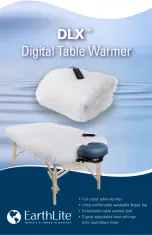
Reflect-O-Ray
®
EDS 6
Installation, Operation & Service
Combustion Research Corporation
WARNING
FIRE OR EXPLOSION HAZARD
Can cause death, severe injury and/or property damage.
1. Read this manual carefully before installing or servicing
this equipment. Improper installation, service or
maintenance can cause death, injury and/or property
damage.
2. Check clearances given on the outside of each burner to
make sure the product is suitable for your application.
3. Installer must be a trained, experienced service
technician.
4. All service must be performed only by a trained service
technician or representative
5. After installation is complete, check system operation as
provided in these instructions.
Combustibles:
Failure to maintain the specified minimum
clearances to combustibles could result in a serious fire
hazard. Do not locate flammable or combustible materials
within this distance. Signs should be posted near thermostat
and in storage areas to specify maximum stacking height to
maintain required clearances to combustibles. Do not locate
in hazardous atmospheres containing flammable vapors or
combustible dust.
United States
: Installations in public garages or airplane
hangars are permitted when in accordance with NFPA-88
(latest edition) and NFPA-409 (latest edition) Codes.
Canada:
Installation in public garages and airplane hangars
is permitted when in accordance with CAN/CGA B.149.1 &
CAN/CGA B149.2.
Vehicles:
Minimum clearances must be maintained from
vehicles parked, below the heater. Ensure that adequate
clearance is maintained where vehicles are in operation or
being serviced.
Gas Connection:
There is an expansion of the radiant pipe
With each firing cycle, and this will cause the burner to move
with respect to the gas line. This can cause a gas leak
resulting in an unsafe condition if the gas connection in not
made strictly in accordance with page 17 of these
instructions.
Ignition:
This appliance does not have a pilot. It is equipped
with an ignition device, which automatically lights the burner.
Do not try to light the burner by hand
.
Mechanical
Hazard - Vacuum Exhauster
: High speed
rotating vacuum exhauster impeller/wheel can cause severe
injury. Do not operate the vacuum exhauster without
impeller. Loose clothing can be drawn into unguarded inlet
and entangle with impeller wheel. Keep hands and fingers
away from inlet and outlet. Install exhaust duct with "bird
screen" or approved vent cap on vacuum exhauster outlet.
Mechanical Hazard - Suspension
: Use appropriate
suspension hardware, beam clamps (rod or perforated
strap) and turnbuckles at predetermined locations. The
weight and normal movement of the heating system may
cause support failure if the following minimum suspension
requirements are not met: Distance between combination
hangers must be 10 ft. (3 m) or less; chain size must be 3/0
minimum or equivalent.
DO NOT
suspend vacuum
exhausters with chain. Failure of the suspension system
and associated supports can cause death, severe injury or
property damage.
NOTICE
CAUTION
Failure to follow these instructions can cause personal injury
or property damage:
Caution should be used when running the system near
combustible materials such as wood, paper, rubber, etc.
Consideration should be given to partitions, storage racks,
hoists, building construction, etc. Page 6 & 7 outlines
minimum acceptable clearances to combustibles.
If the building has a slight negative pressure or
contaminants are present in the air, an outside combustion
air supply to the heaters is strongly recommended.
Do not use in an atmosphere containing halogenated
hydrocarbons or other corrosive chemicals. Some
compounds in the air can be drawn into the equipment and
can cause an accelerated rate of corrosion of some parts of
the radiant heat exchanger. The use of such chemical
compounds in or near the enclosure should be avoided
where a longer life of the burner, tubing and other parts is
desirable.
Failure to follow these instructions can cause damage to the
system components:
DO NOT
high-pressure test the gas piping with the burners
connected. Failure to follow this procedure will exceed the
pressure rating of burner gas controls and this will
require
complete replacement of these parts.
DO NOT
operate a vacuum exhauster with an unrestricted
inlet. Operating a vacuum exhauster when not installed on
a system requires the use of a damper that is one-half
closed. An unrestricted airflow will overload the motor,
which can cause burnout or failure.
This heater is designed for heating nonresidential indoor
spaces. These instructions, the layout drawing, local codes
and ordinances, and applicable standards that apply to gas
piping, electrical wiring, venting, etc. must be thoroughly
understood before proceeding with the installation.
!
!



































